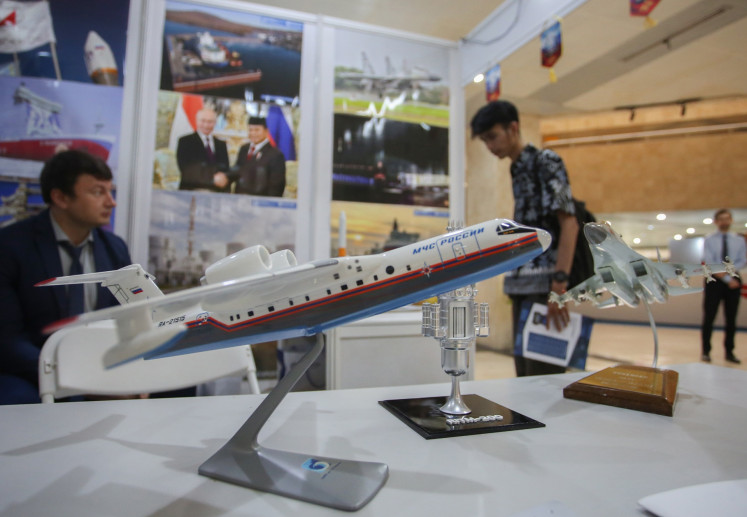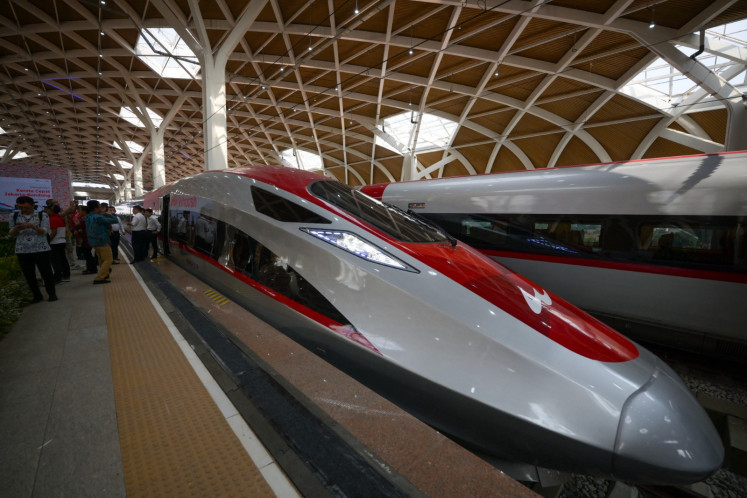Popular Reads
Top Results
Can't find what you're looking for?
View all search resultsPopular Reads
Top Results
Can't find what you're looking for?
View all search resultsKey issues in post-pandemic ASEAN economic recovery
Digital technology adoption, supply chain resilience, and skills development are going to be even more integrated in the post-pandemic world, and thus require a coordinated development strategy.
Change text size
Gift Premium Articles
to Anyone
 Sole proprietor: A shoemaker in Tasikmalaya, West Java, photographs his products for online marketing on July 3, 2020. The Communications and Information Ministry has said that 9.4 million micro, small and medium enterprises (MSMEs) have gone digital. (Antara/Adeng Bustomi)
Sole proprietor: A shoemaker in Tasikmalaya, West Java, photographs his products for online marketing on July 3, 2020. The Communications and Information Ministry has said that 9.4 million micro, small and medium enterprises (MSMEs) have gone digital. (Antara/Adeng Bustomi)
T
he three main challenges ASEAN will face post-pandemic – digitalization, supply chains, and human capital – have been widely discussed. Each of these has been emphasized in the ASEAN Comprehensive Recovery Framework (ACRF) and its implementation plan.
Undoubtedly, ASEAN’s continued prosperity requires proper management of its evolution during the “new normal". But what needs to be emphasized is that digital technology adoption, supply chain resilience, and skills development are going to be even more integrated in the post-pandemic world, and thus require a coordinated development strategy.
We know that digitalization has accelerated due to the pandemic. The pandemic has forced us to push the limits of digital technology, and we are learning more about its efficiency and effectiveness. There are also large investments geared toward making digital interaction more seamless.
The constantly improving efficacy of digital technology in performing economic transactions will make it an indispensable tool. In particular, digitalization will feature heavily in supply chains, which is itself undergoing profound transformation.
The COVID-19 pandemic has forced many businesses to rethink their supply chains. In the short term, they had to adjust to the disruptions in flow of goods and people due to domestic lockdowns and border closures. This also forced them to look for ways to increase supply chain resilience. Businesses have three options in this regard – consolidation, diversification, and reshoring.
Consolidation is done to try to keep suppliers close to production bases, for example by sourcing input locally. Diversification consists of finding multiple sources of input either domestically or in new countries.
Finally, reshoring is returning economic activity back to the home base. Digital technology will play a key role in which of these options are preferable to firms.
Consolidation and reshoring are related to the concentration force of technology, while diversification is related to the dispersion force of technology. As Prof. Fukunari Kimura, chief economist of ERIA, explained, concentration is when economic activity gets consolidated. By using technology, firms can perform a lot of activities that normally require outsourcing. In particular, technology can be labor-saving in that tasks done by humans can now be automated and done by computers.
There is less reason for multinationals to seek low-wage countries for cost savings. Instead, they can invest in technological upgrading. At the same time, technology also creates dispersion forces so that more economic activity can be coordinated at a distance.
With seamless communication, it is not necessary for production to take place in the same location, but this can be dispersed across multiple places.
For ASEAN, maintaining the vitality of supply chains is necessary, so it needs to pay attention to reorganization. After all, ASEAN’s economic growth has been driven by forming strong international production linkages within ASEAN and with East Asia. But supply chains in the digital age will look a lot different. In particular, due to the greater role of digital technology in supply chains, digital infrastructure and skills development has become vital for supply chain vitality.
As the types of economic activity and related technologies change, so does demand for corresponding skills. In the past few decades, much of ASEAN growth relied on foreign investment in labor-intensive manufacturing sectors, which easily complemented the types of skills ASEAN workers could offer. However, technological developments have outpaced the upgrading of our skill development system, so now many ASEAN workers do not possess the skills needed in the new jobs that are being created. The future of work looks great for workers who possess the right kinds of skills. Workers and firms that can harness and complement digital technology will greatly benefit from these trends.
Skills development is not only an enabler of technology adoption and supply chain resilience, but also depends on it. Skill acquisition is a decision made by individuals by comparing the cost and benefits of investing in these skills. Technology adoption and vibrant economic activity will ensure that there are adequate opportunities for the workforce to hone their skills.
As demand for workers that complement digitalization grows, their wages will rise faster than those without such skills. In response to rising wages, individuals would normally acquire the skills that are in high demand; this increasing supply would check the rise in wages while also enabling more people to benefit from digitalization.
But the ability of workers to respond to signals from the market will largely depend on their access to the skills development system. A system needs to be in place that will enable workers to inculcate skills that will be highly valued in a digitalized world.
ASEAN policymakers need to think of digitalization, supply chain resilience, and skills development within an integrated recovery and growth strategy. Digital technology offers opportunities for ASEAN countries to revitalize their traditional sectors like agriculture and manufacturing and enhance productivity of the MSMEs.
But to take full advantage, businesses need to access a global market by plugging into supply chains and engaging a skilled workforce. Likewise, a resilient supply chain is necessary for ASEAN’s continued growth. It will ensure that ASEAN consumers can access goods and services at a low cost from everywhere, and that ASEAN firms can engage in the global value chain.
But attracting new investment in supply chain activity will require expansion of digital technology and a skilled workforce.
***
The writer is an economist at Economic Research Institute for ASEAN and East Asia (ERIA). These views expressed are their own.









